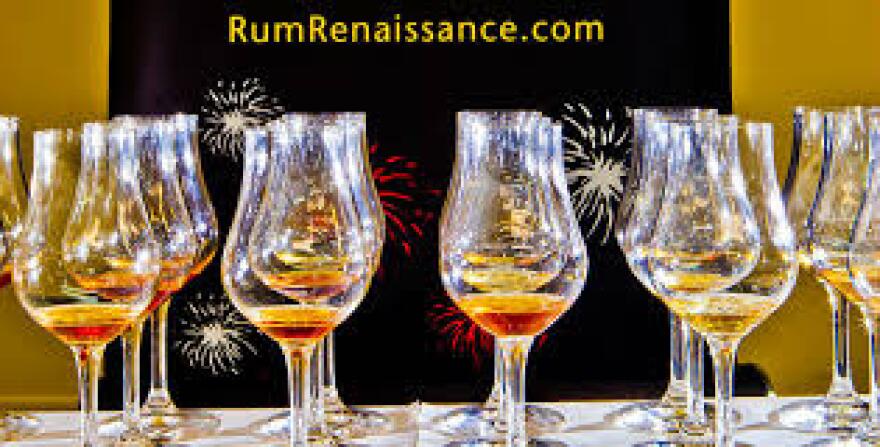There was a time when rum was rotgut. Blackbeard the pirate liked to mix his cane alcohol with gunpowder and light it. Rum and croak.
Fast forward a few centuries to rum respectability – specifically, to Rob Burr’s patio deck in Coral Gables.
From the waterfall pond to the tiki bar, it sets a mood not for swilling rum but for tasting it. Not the way spring-breakers chug Captain Morgan but the way cognac drinkers sip Napoleon. Not with Coke (or gunpowder) but neat, in a snifter.
Burr, his wife Robin and their son Rob Jr. are one of the most expert teams of rum aficionados in South Florida – and their house is a virtual repository of the stuff. Says Burr Sr., “There are probably a thousand or 1,200 rums sitting around here.”
The Burrs appraise all of it, pouring their notes into the authoritative Rob’s Rum Guide. That in turn helps set the stage for the annual Miami Rum Renaissance Festival, or Miami Rum Fest, which they’ll host this weekend at the Doubletree Hotel near Miami International Airport.
RELATED: Bottoms Up: The Liquor & Wine Business In South Florida
The event, which drew 12,000 visitors last year, has become a central stage for what you might call the rum revolution – the recent ascent of high-end, premium rum. Don’t let the name Rum Fest fool you. It’s not a college beach bacchanal; it’s rum for grown-ups, for people who know that most aged rums today are distilled as masterfully as fine cognacs and single-malt Scotches.
"We'd call it a renaissance," Burr Sr. says. As he puts it, part of the festival's mission is to “change the perception of rum. It’s perceived as ordinary when in fact it’s fascinating.”
We'd call it a rum renaissance. Rum is perceived as ordinary when in fact it's fascinating. - Rob Burr
The trend is most of all a Caribbean coming-of-age party. There’s hardly a country or island in the basin these days that doesn’t produce an upmarket aged rum – whose prices can range from $25 to $250 or more per bottle.
Among some of the best: Santa Teresa 1796 from Venezuela; Matusalem from the Dominican Republic; Bielle Rhum Vieux from a speck on the map called Marie-Galante.
Many rum master blenders are now industry rock stars. Lorena Vásquez blends one of the most acclaimed rums, Zacapa, in Guatemala. “These rums,” she says, “have become some of the Caribbean’s most prized ambassadors. They’re a marvelous reflection of our culture.”
But if this is about a new boom in the spirits industry, it’s also about a new bond between the Caribbean and South Florida. Very little rum is actually made in Miami. Still, as the Rum Fest suggests, rum reputations are. The city today is rum’s premiere showcase, as evidenced by the more than 80 fine rums on the menu at Ortanique, a Caribbean restaurant in Coral Gables.
“It’s almost a natural for Miami and South Florida to be the Mecca of rums,” says Joel Garcia, Ortanique’s bar manager. “It’s always been the depot for the Caribbean, whether it’s the melding of people or the melding of spirits.”
One of Garcia’s favorites: “Pyrat, from the British West Indies, if you wanna try something that will blow you away in a snifter.”
CULT FOLLOWING
Despite the almost cult following these rums are building in the 21st Century – reminiscent of the craze for The Glenlivet and similar silky Scotches at the end of the 20th – sales of premium rums aren’t yet blowing away cognacs or single-malts. But they’re rising year after year; and ironically, that’s partly because rum in general carries a younger, hipper cachet than those other spirits do.

That may help explain why spirits giant Bacardi of Puerto Rico finally released its own line of premium aged rums last year, including Paraíso, which sells for $250.
Says Toby Whitmoyer, vice president for rum at Bacardi USA in Coral Gables: “This really for us was a critical move to share with the world what we believe rum can truly be.”
Imbibing rum the way wine connoisseurs savor Bordeaux might sound pretentious. But spend a tasting session with the Burr family and you do realize how rich and complex rum’s character can be when it’s not tied to a Mai Tai or when it’s liberated from a Cuba libre.
The bounty their noses and palates glean from rum – from dried fruit to cola notes, pineapple to vanilla, chocolaty port to balsamicky wood – seems to capture all the flavors of the Caribbean. And, for Robin, all the colors, especially the golden brown hues that hint at the honey quality of many aged rums. "Maybe it's because I'm a woman," she jokes, "but that is very appealing to me.”
Like the Burrs, Vásquez of Zacapa likes to point out that rum too is a product of terroir – not just its prime material, sugar cane, but the soil, climate and faster barrel-aging involved in the tropics. (The Caribbean blending process is often called the "Solera" method.) “To achieve those special aromas and flavors,” says Vásquez, “we’re as careful as cognac-makers are.”
Makes sense. After all, many argue rum’s real renaissance started in 1862 – when French cognac-maker Dupré Barbancourt, supposedly heartbroken over his first wife’s death, emigrated to Haiti and helped refine the way rum is made. Hence one of Burr Jr.’s favorite new bottles:
“A special 150-year anniversary of Rhum Barbancourt,” he says. “This is actually closer to cognac.”
But it’s rum. Vive la différence.
The Miami Rum Renaissance Festival will be held Friday, April 25, through Sunday, April 27, at the Doubletree by Hilton Miami Airport Convention Center. Daily general admission tickets are $50.
Tim Padgett is WLRN's Americas editor. You can read more of his coverage here.






